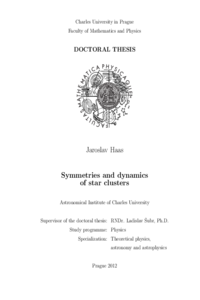Symmetries and dynamics of star clusters
Symetrie a dynamika hvězdokup
rigorózní práce (UZNÁNO)

Zobrazit/
Trvalý odkaz
http://hdl.handle.net/20.500.11956/59258Identifikátory
SIS: 137501
Kolekce
- Kvalifikační práce [10690]
Autor
Fakulta / součást
Matematicko-fyzikální fakulta
Obor
Astronomie a astrofyzika
Katedra / ústav / klinika
Ústav teoretické fyziky
Datum obhajoby
26. 6. 2013
Nakladatel
Univerzita Karlova, Matematicko-fyzikální fakultaJazyk
Angličtina
Známka
Uznáno
Klíčová slova (česky)
metody: numerické -- metody: analytické -- hvězdná dynamika -- nebeská mechanika -- Galaxie: jádroKlíčová slova (anglicky)
methods: numerical -- methods: analytical -- stellar dynamics -- celestial mechanics -- Galaxy: nucleusZabýváme se studiem orbitálního vývoje tenkých hvězdných disků kolem su- permasivních černých děr. Uvažujeme přítomnost různých poruchových zdrojů gravitačního potenciálu. Metodou přímého numerického N-částicového mod- elování se nejprve zaměřujeme na situaci, kdy je disk zanořen do rozsáhlé, sféricky symetrické hvězdokupy. Naše výsledky naznačují, že v gravitačním poli disku dochází uvnitř hvězdokupy k formování makroskopické nesférické struk- tury, jejíž potenciál následně zpětně ovlivňuje vývoj disku. Za předpokladu, že je hvězdokupa nahrazena sféricky symetrickým analytickým potenciálem, dále započítáváme působení dodatečného osově symetrického potenciálu. Po- mocí jednoduchého semi-analytického modelu ukazujeme, že tento potenciál způsobuje vzájemné spřažení jednotlivých drah z disku, což vede k koherentnímu vývoji jeho nejhustších částí. Získané výsledky jsou aplikovány na disk mladých hvězd, který se pozoruje v centrálním parseku naší Galaxie. 1
We investigate the orbital evolution of an initially thin stellar disc around a supermassive black hole, considering various perturbative sources of gravity. By means of direct numerical N-body modelling, we first focus on the case when the disc is embedded in an extended spherically symmetric star cluster. We find that the gravitational influence of the disc triggers formation of macroscopic non- spherical substructure in the cluster which, subsequently, significantly affects the evolution of the disc itself. In another approximation, when the cluster is emu- lated by an analytic spherically symmetric potential, we further consider pertur- bative gravitational influence of a distant axisymmetric source. Using standard perturbation methods, we derive a simple semi-analytic model for such a config- uration. It turns out that the additional axisymmetric potential leads to mutual gravitational coupling of the individual orbits from the disc. Consequently, the dense parts of the disc can, for some period of time, evolve coherently. Finally, we apply some of our results to the young stellar disc which is observed in the innermost parsec of the Galactic Centre. 1
